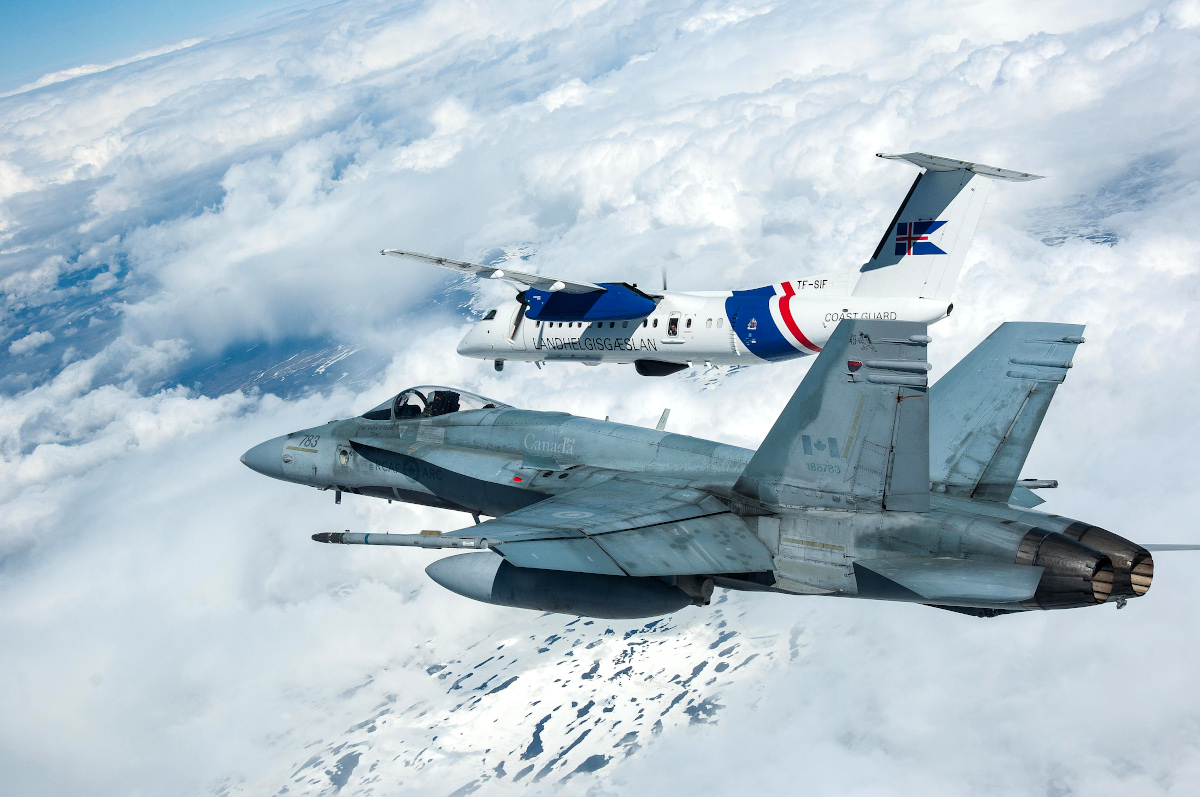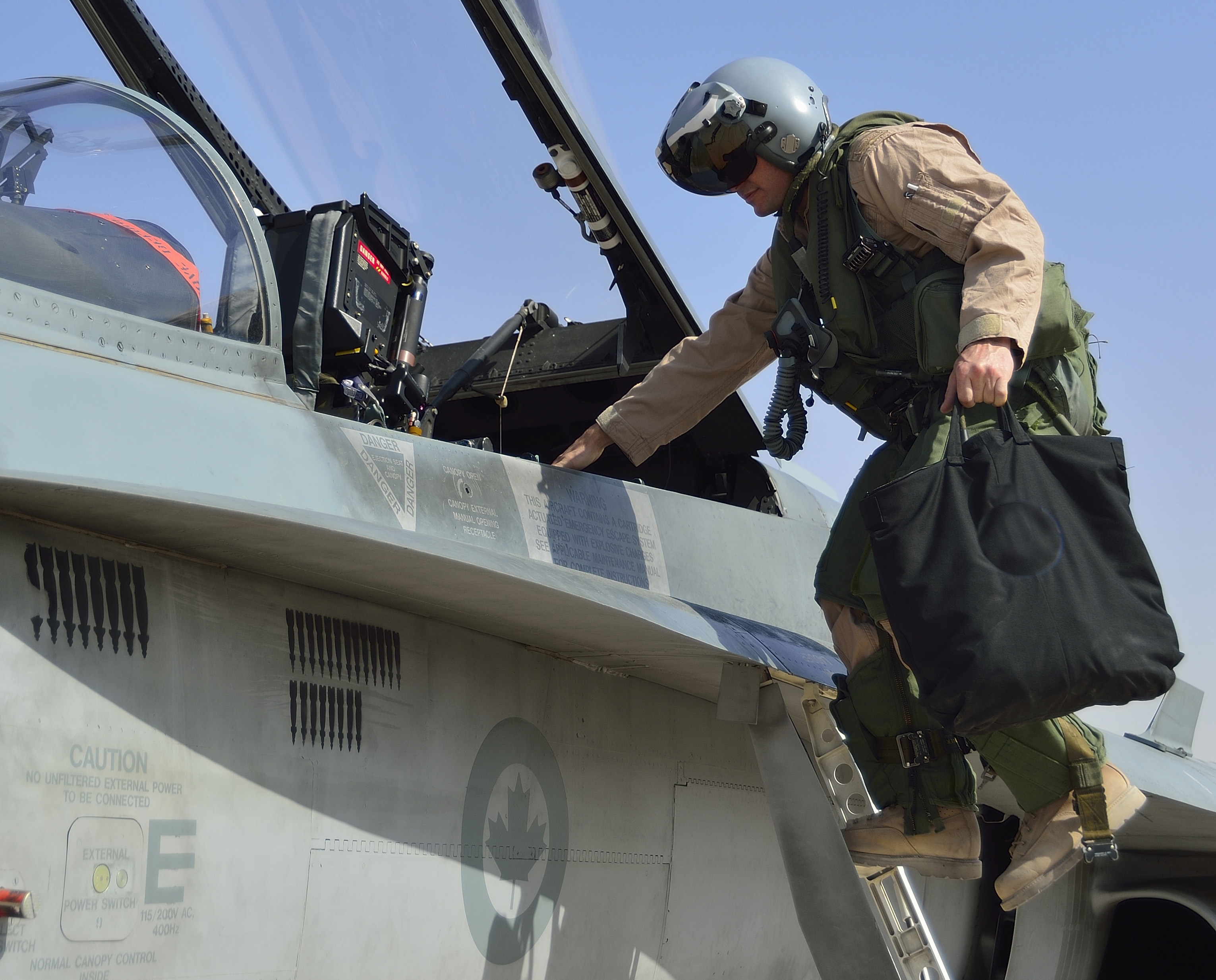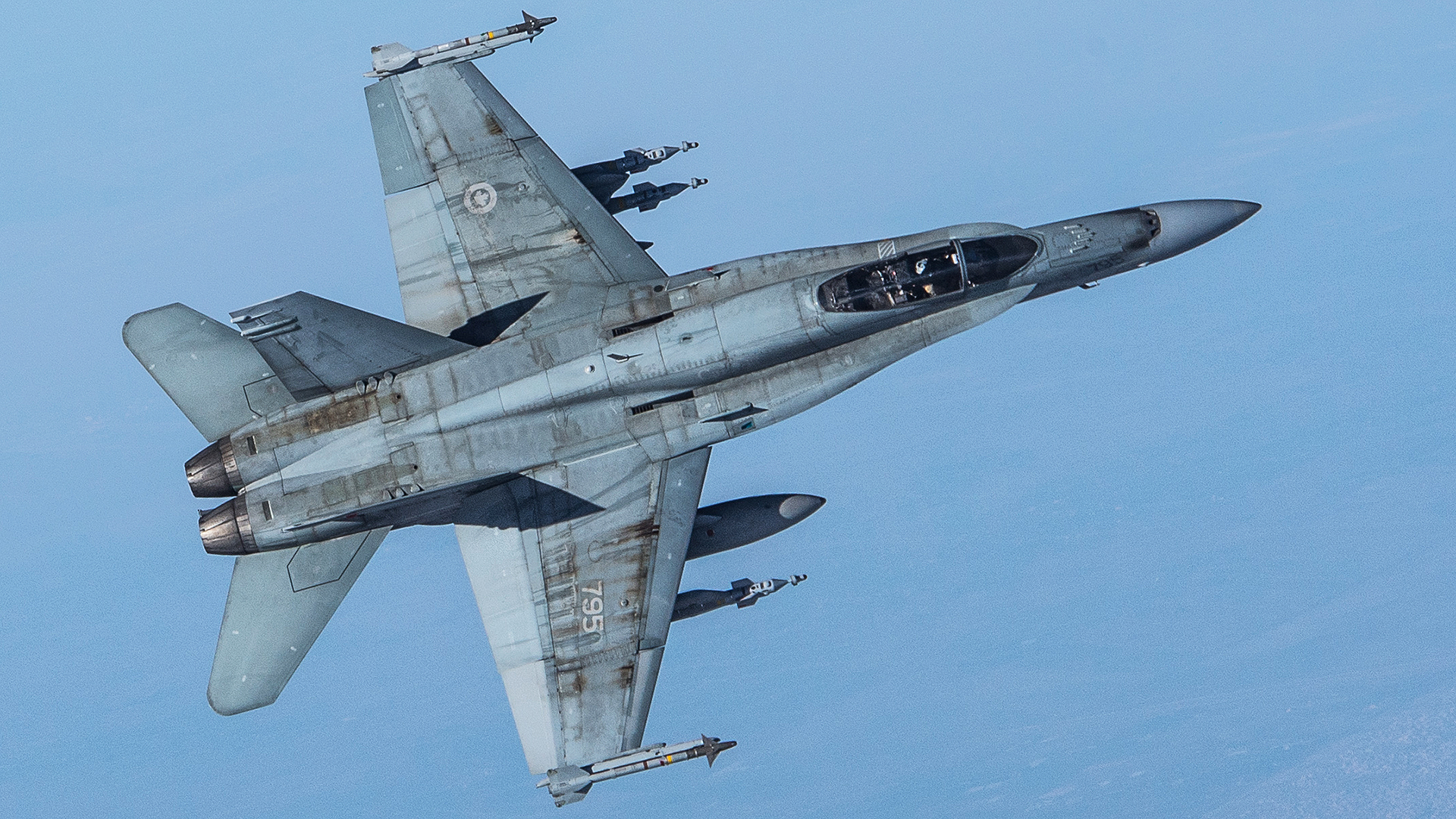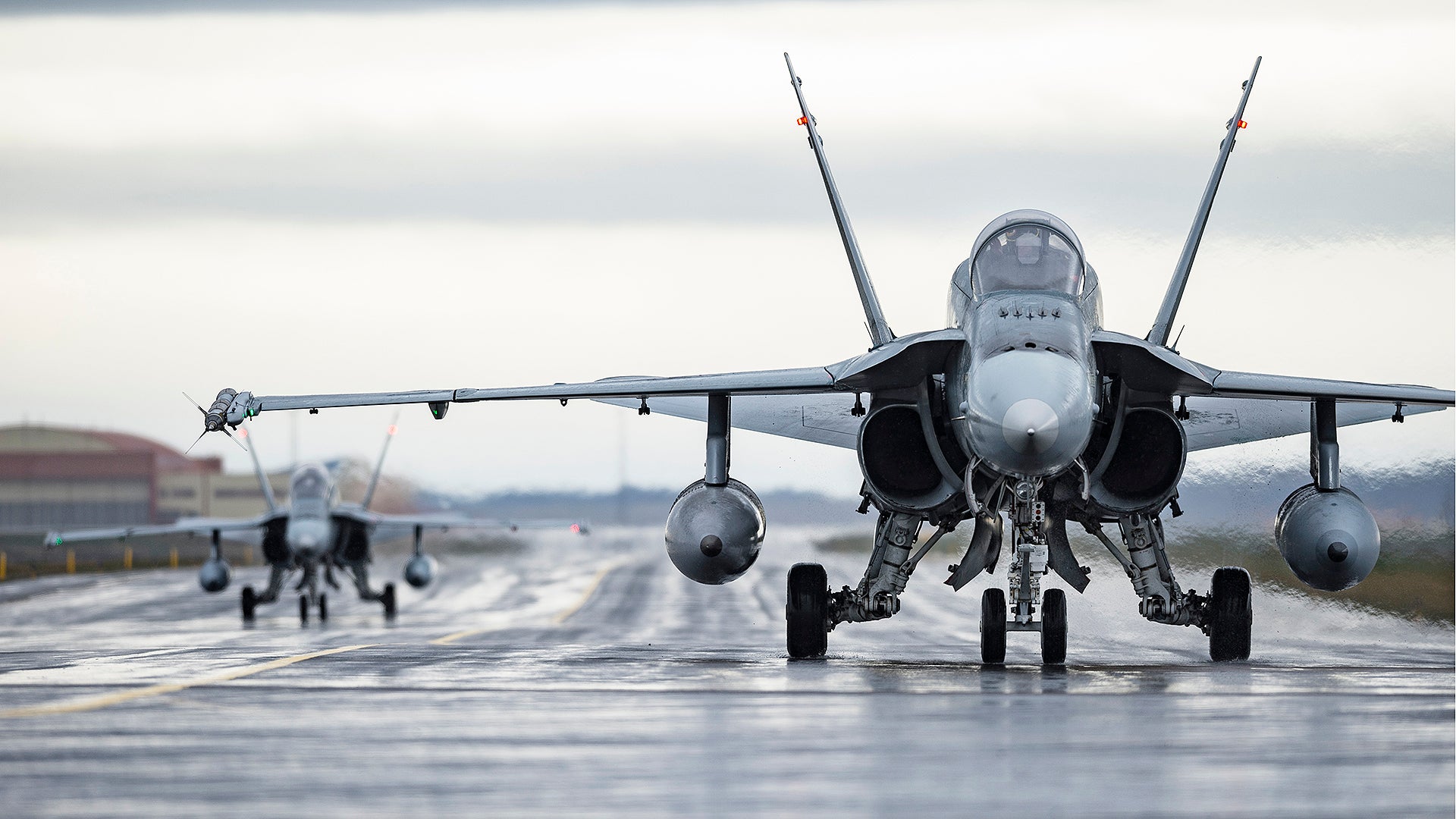The U.S. government has approved the potential sale of an extensive upgrade package, dubbed the Hornet Extension Program, for Canada’s CF-18A/B+ Hornet fighter jets. The proposed deal most notably includes enough AN/APG-79(V)4 active electronically scanned array (AESA) radars to equip two squadrons worth of jets, which would give those aircraft a desperately needed boost in their ability to detect, track, and engage threats at extended ranges.
The U.S. military’s Defense Security Cooperation Agency (DSCA) announced that the State Department had signed off on the prospective sales, valued at $862.3 million in total, on June 16, 2020. In addition to the 38 radars, the package now on offer also includes 50 AIM-9X Block II air-to-air missiles, as well as additional training versions of the AIM-9X, and 20 AGM-154C Joint Stand-Off Weapon (JSOW) glide bombs. The Royal Canadian Air Force already has stocks of AGM-154s, but notably does not have any AIM-9Xs, the newest and most capable variant in the Sidewinder family. You can read more about the AIM-9X Block II, which is a further upgrade over the basic AIM-9X, and the AGM-154C in these respective War Zone pieces.

Further upgrades and ancillary items and support services, including the addition of an Automated Ground Collision Avoidance System (Auto GCAS) for the jets, 30 ADM-141C Improved Tactical Air-Launched Decoys (ITALD), Data Transfer Device/Data Transfer Units, AN/ARC-210 RT-2036 (Gen 6) radios, and software updates for the Advanced Distributed Combat Training System (ADCTS) flight simulators to reflect the upgrades, are part of the package, as well. The full itemized list from the DSCA statement is as follows:
“The Government of Canada has requested to buy fifty (50) Sidewinder AIM-9X Block II Tactical missiles; fifty (50) Sidewinder AIM-9X Block II Captive Air Training Missiles (CATMs); ten (10) Sidewinder AIM-9X Block II Special Air Training Missiles (NATMs); ten (10) Sidewinder AIM-9X Block II Tactical Guidance Units; ten (10) Sidewinder AIM-9X Block II CATM Guidance Units; thirty-eight (38) APG-79(V)4 Active Electronically Scanned Array (AESA) radar units; thirty-eight (38) APG-79(V)4 AESA Radar A1 kits; twenty (20) Joint Standoff Weapon (JSOW) C, AGM-154C; forty-six (46) F/A-18A Wide Band RADOMEs. Also included are additional technical and logistics support for the AESA radar; upgrades to the Advanced Distributed Combat Training System (ADCTS) to ensure flight trainers remain current with the new technologies; software development to integrate the systems listed into the F/A-18A airframe and install Automated Ground Collision Avoidance System (Auto GCAS); thirty (30) Bomb Release Unit (BRU) – 42 Triple Ejector Racks (TER); thirty (30) Improved Tactical Air Launched Decoy (ITALD); one hundred four (104) Data Transfer Device/Data Transfer Units (DTD/DTU); twelve (12) Joint Mission Planning System (JMPS); one hundred twelve (112) AN/ARC-210 RT-2036 (Gen 6) radios and F/A-18 integration equipment; support equipment; tools and test equipment; technical data and publications; U.S. Government and contractor engineering, technical, and logistics support services; and other related elements of logistical and program support. The total estimated program cost is $862.3 million.”

“This proposed sale will support the foreign policy and national security objectives of the United States by helping to improve the military capability of Canada, a NATO ally that is an important force for ensuring political stability and economic progress and a contributor to military, peacekeeping and humanitarian operations around the world,” DSCA’s notice regarding the proposed deal says. “This sale will provide Canada a 2-squadron bridge of enhanced F/A-18A aircraft to continue meeting NORAD and NATO commitments while it gradually introduces new advanced aircraft via the Future Fighter Capability Program between 2025 and 2035.”
The Royal Canadian Air Force (RCAF) presently has around 75 CF-18A/B+ Hornets, which it first acquired in the 1980s and which have received significant upgrades in the past, including the addition of the improved AN/APG-73 mechanically-scanned pulse-doppler radar. These aircraft, which have also deployed overseas for combat missions over Iraq and Afghanistan, continue to form the core of the RCAF’s contribution to the U.S.-Canadian North American Aerospace Defense Command (NORAD), which guards the airspace over both countries, as well as its participation in NATO’s rotational air policing missions over Iceland and the Baltic Sea region.


The RCAF is also in the process of acquiring an additional 25 ex-Royal Australian Air Force (RAAF) F/A-18A/B models, 18 of which are set to eventually enter operational service after receiving their own modifications to bring them up to Canadian standards. The remaining seven jets will be used as sources of spare parts.
As is the case with the proposed upgrade package for the CF-18A/B+s, the acquisition of the former RAAF jets is also supposed to help bolster the RCAF’s aging Hornet fleet until the country’s Department of National Defense selects a replacement type, a decision that government auditors have since slammed as a bad deal that is unlikely to provide a meaningful increase in overall capability. Canada’s efforts to acquire a new fleet of 88 fighter jets is a long-running and controversial saga of its own that you can read about in more detail in these past War Zone pieces.

If Canada does proceed with the purchase of this upgrade package it could significantly boon for the two squadrons worth of aircraft that receive the enhancements. The addition of the AN/APG-79(V)4 active electronically-scanned array (AESA) radar, an adapted version of the Super Hornet’s radar which slots directly into the Legacy Hornet’s existing radar bay, by itself is a relatively efficient and low-effort means of drastically improving the capabilities of its Hornets.
Compared to older mechanically-scanned array radars, AESAs can spot and track targets further away and with greater speed and accuracy, even against smaller and harder to detect threats, such as low flying cruise missiles—a capability that is becoming increasingly important for the NORAD air sovereignty mission. The increased power they offer also means they generally have better target discrimination capabilities and multi-target tracking capabilities, as well as greater resistance to electronic warfare systems. Above all else, they are more reliable than their mechanically scanned array counterparts. You can read more about AESA radars in this past piece of ours.

This could be very useful when combined with the AIM-9X Block II’s expanded engagement envelope, which is thanks to its two-way data link and lock-on after launch capability. The AIM-9X, even the Block I variant, can also take better advantage of cueing from the aircraft’s improved radar, in general. However, these radars would be even more valuable when combined with the improved AIM-120D Advanced Medium-Range Air-to-Air Missile (AMRAAM). Canada had gotten approval to buy those missiles back in 2017, but without the AESA radars for its Hornet that would’ve been essential for getting the most of them. You can read all about this interesting situation in this past piece of ours. There is no indication that the Canadian government followed through with that purchase in the end, though it may be something they move forward with now.

Canada’s preset lack of AIM-9Xs also limits its Hornet’s within-visual-range combat capability. The RCAF is still using the AIM-9L/M, which does not have high off-boresight targeting and engagement capability, yet their CF-18s have been equipped with the Joint Helmet Mounted Cueing Systems (JHMCS) that are used to target the AIM-9X by the pilot looking at the target. The F-22 famously has the opposite issue. It has the AIM-9X, but no helmet-mounted display to get the most out of the missile. Regardless, this capability mismatch will be plugged if this acquisition goes through and the RCAF’s fighter pilots can finally get the most out of their JHMCS.

Upgrading at least a portion of the RCAF CF-18A/B+ aircraft could become increasingly more of a necessity as delays and other issues continue to dog Canada’s fighter replacement plans. This year alone, the Department of National Defense has already twice pushed back the deadline for companies to just submit their final bids, in part due to the COVID-19 pandemic. Firms now have until July to send in their offers.
The expected competitors are Lockheed Martin’s F-35 Joint Strike Fighter, Boeing’s F/A-18E/F Super Hornet, and the Saab Gripen E. France’s Dassault, which had planned to pitch its Rafale, announced it was dropping out in 2018 over technical data-sharing requirements and the need for a high degree of interoperability with American combat aircraft because of the NORAD mission.
Canadian authorities still hope to receive the first of the country’s new fighter jets in 2025 and have the full fleet of 88 aircraft operational within around a decade after that. It remains to be seen if they will be able to keep to that schedule.

In the meantime, the CF-18A/B+s will continue to soldier on, but with roughly half the active fleet potentially getting this upgrade, it will certainly give them a considerable capability boost and put them inline with just under 100 USMC F/A-18C/Ds that are slated to get a similar set of enhancements.
Canada still has to officially move forward with the plan now that the potential sale is approved by the U.S. Government, but at this point, it seems like they have little choice.
Contact the authors: Tyler@thedrive.com / joe@thedrive.com
